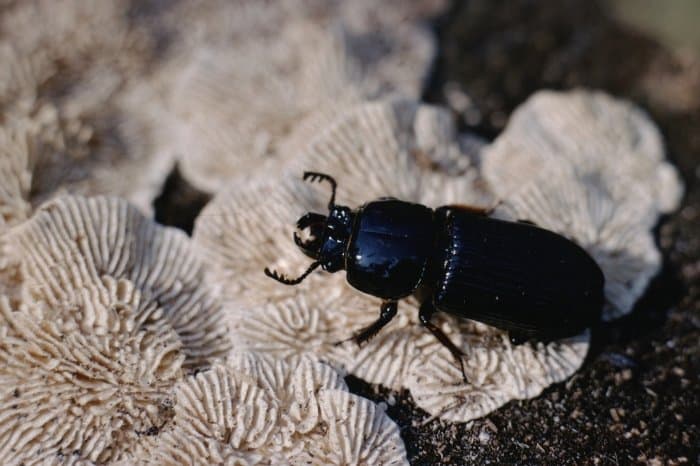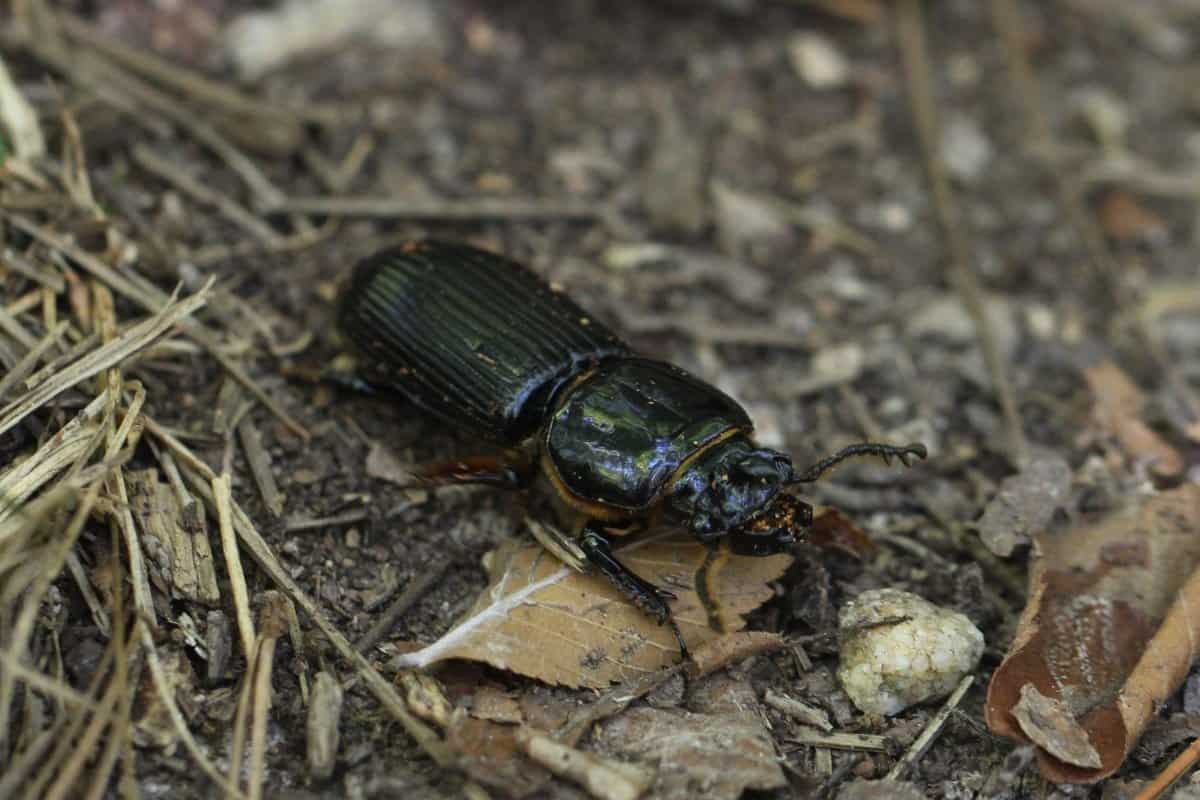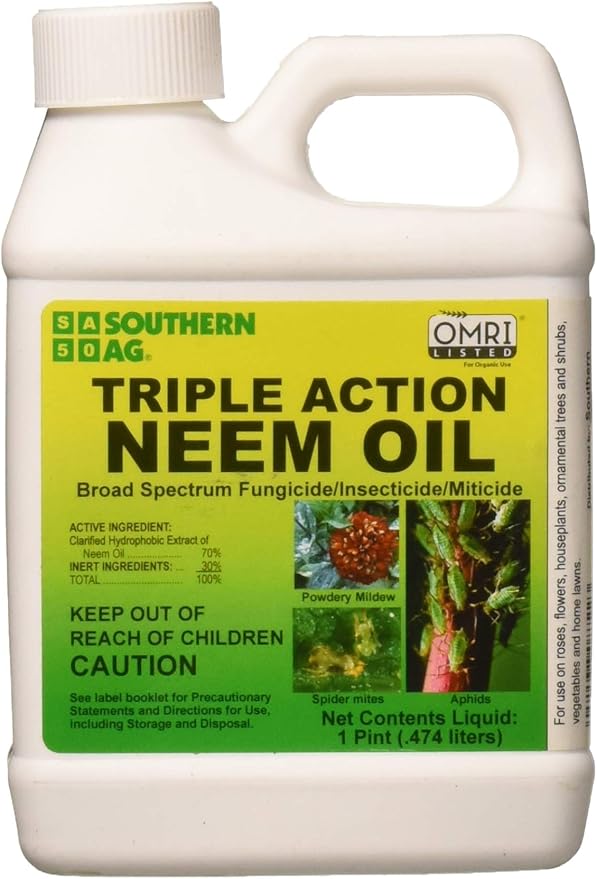Last Updated on January 23, 2022 by
What is a Bessie bug is a question we have received from plenty of gardeners who either come across these insects or just want to learn about them.
A Bessie bug, Bess bug, or Betsy bug (Odontotaenius disjunctus)is a 1.5-inch long black beetle that is also known as a patent leather beetle (because of their shiny black wing), horn beetle, pinch bug, or horned passalus. It belongs to the beetle family (family Passalidae) of the over 500 species of beetles mostly found in the tropics.
This insect loves to live in humid climates across the US from Florida through Texas to Minnesota, Nebraska, and Massachusetts.
This bug is harmless and beneficial so do not go killing it and it feeds on rotting wood. They are large, ranging between 30 and 40 mm in length. They are flat and squarish with a horn that points forward at the top of the head.
Where Do The Bessie Bug Commonly Live?
Bessie bugs live together as a family under the bark of decaying logs. Both the male and female process decaying wood as food and feed it to their larvae. The only group of insects that exhibit this similar behavior between males and females is the termites.
Beetles love the well-rooted hardwood logs, stumps, and other decaying wood in deciduous forests. Both the larvae and adults eat wood. They create winding tunnels in wood and live together in family groups with the males and females tending and feeding the larvae.
Bess beetle adults and larvae communicate by sounds audible to humans. Most people wonder what sounds are those that beetles make. The adult rubs its wings across rough patches on the abdomen and the larva rubs its vestigial hind pair of legs against its middle legs.
What Is A Betsy Bug Eating?
Both adults and larvae love to eat rotting wood or hardwood logs plus the fungi and juices associated with it. Adults feed the larvae by chewing wood to soften it before feeding it to the larvae.
Beetles do not eat anything else except wood. That is why you should not destroy them when you come across them.
Check out How to Get Rid of Japanese Beetles on Roses
What Is The Lifecycle Of The Bessie Bug?
Beetles live for more than a year. Although they fly, they do not do it commonly especially the adults. They tend to stay in the galleries and tunnels in their colony’s home. When the adults fly, it may be for mating or dispersal or because light captivates them.
Mating takes place in the colony and eggs hatch into larvae fed by adults until they are mature. They grow, molt, pupate and then emerge as adult beetles.

Bessie Bug’s Connection With Humans
Although they give humans a genuine pinch that feels like a sting, they cannot harm you at all. Do you know there were some people who believed this beetle could cure an earache? These people were the Ozarkers and they believed its blood was medicine. They called this insect the Betsy bug.
This is not known today as truth or myth because it has not been verified. In addition, no one knows if this group of people continue to use this method to treat earache.
Read more about How to Get Rid of Aphids
Bessie Bug’s Ecosystem Connections
This insect plays an important role in the ecosystem system that most people do not know about. It has a critical role in cycling nutrients in rotting logs back into the soil while richening the earth and helping to clear the forest or fallen timber.
Animals including the woodpeckers and raccoons poke or probe through the rotting logs eating the grubs. This is easy because the Bessie bugs that burrow through the logs for food and living.
Southern Ag 08722 Triple Action Neem Oil Fungicide Insecticide Miticide, Brown
Other animals like birds, skunks, bats, frogs eat the adult bugs when they get out of their colony’s log. Mites and other insects feed on bot larvae and adults too.
FAQs
What do a Bessie Bug look like?
I've seen them with long legs, short legs, or no legs at all. And I've also seen bessie bugs that have antennae that are big and fat and others with antennae that are skinny and small. But there is one thing that's pretty much constant about all bessie bugs: their eyes.
The bessie bug's eyes are generally yellowish in color, with the exception of the soldier bug (above). The soldier bug's eyes are a deep black color. Most bessie bugs have compound eyes. This means that the eye is made up of many tiny eyes that are attached to each other.
Bessies may be found from the southern United States to southern Canada and the Great Lakes region. They are especially common in the South, where they can be found year-round. Bessies may be found on wood, bark, leaves, and other plant materials.
Can Bess beetles fly?
The answer is yes.
The Bess beetle (Anthribus bicolor) is an insect of the family Scarabaeidae. It is a member of the subfamily Dynastinae and the tribe Dynastini. The genus Anthribus is monotypic. It contains only one species, Anthribus bicolor.
The Bess beetle is a nocturnal beetle that feeds on decaying organic matter. It lives in the soil and can be found from southern Canada to Mexico.
Where can I find a bess beetle?
Bess beetles are common in the USA. The most common species of bess beetle are Bessia angustifrons, Bessia longula, Bessia parvula, and Bessia yanagae (Hendel). Bess beetles have been found to be the most abundant carrion feeder in the world. Bess beetles are found in the US and Canada, and in the northern regions of Europe. Bess beetles are usually found in the wild on sandy shores, in dry dunes and in arid regions. They may be seen in gardens, especially on the coast where they have access to sand for breeding.
What do Bess beetles eat?
The Bess beetle is a common garden pest. It can be found in all of the warm temperate zones, and it is often found feeding on the flowers and leaves of many different plants. However, it does not feed on all plant species. For example, it will not feed on the flowers or fruits of some citrus species, as well as certain plants in the rose family, such as roses. It is also a social insect.
There are many different species of Bess beetles that vary from 2 to 20 mm long. They have very strong jaws, so they do not need to chew their food before they eat it. The Bess beetle has two pairs of wings, and it can fly. The Bess beetle lives in both the larval and adult stages. As a larva, it is found in the soil and on decaying plants.
As an adult, it can be found in the bark of trees and logs, and as well as in the leaf litter under tree trunks. It is also found in piles of firewood. The Bess beetle’s larvae are generally considered to be pests. Larvae of this species are called bess bugs. They eat fungi, roots, and decaying plant matter.
Bessy Bug Conclusion
FAQs
What do a Bessie Bug look like?
I've seen them with long legs, short legs, or no legs at all. And I've also seen bessie bugs that have antennae that are big and fat and others with antennae that are skinny and small. But there is one thing that's pretty much constant about all bessie bugs: their eyes.
The bessie bug's eyes are generally yellowish in color, with the exception of the soldier bug (above). The soldier bug's eyes are a deep black color. Most bessie bugs have compound eyes. This means that the eye is made up of many tiny eyes that are attached to each other.
Bessies may be found from the southern United States to southern Canada and the Great Lakes region. They are especially common in the South, where they can be found year-round. Bessies may be found on wood, bark, leaves, and other plant materials.
Can Bess beetles fly?
The answer is yes.
The Bess beetle (Anthribus bicolor) is an insect of the family Scarabaeidae. It is a member of the subfamily Dynastinae and the tribe Dynastini. The genus Anthribus is monotypic. It contains only one species, Anthribus bicolor.
The Bess beetle is a nocturnal beetle that feeds on decaying organic matter. It lives in the soil and can be found from southern Canada to Mexico.
Where can I find a bess beetle?
Bess beetles are common in the USA. The most common species of bess beetle are Bessia angustifrons, Bessia longula, Bessia parvula, and Bessia yanagae (Hendel). Bess beetles have been found to be the most abundant carrion feeder in the world. Bess beetles are found in the US and Canada, and in the northern regions of Europe. Bess beetles are usually found in the wild on sandy shores, in dry dunes and in arid regions. They may be seen in gardens, especially on the coast where they have access to sand for breeding.
What do Bess beetles eat?
The Bess beetle is a common garden pest. It can be found in all of the warm temperate zones, and it is often found feeding on the flowers and leaves of many different plants. However, it does not feed on all plant species. For example, it will not feed on the flowers or fruits of some citrus species, as well as certain plants in the rose family, such as roses. It is also a social insect.
There are many different species of Bess beetles that vary from 2 to 20 mm long. They have very strong jaws, so they do not need to chew their food before they eat it. The Bess beetle has two pairs of wings, and it can fly. The Bess beetle lives in both the larval and adult stages. As a larva, it is found in the soil and on decaying plants.
As an adult, it can be found in the bark of trees and logs, and as well as in the leaf litter under tree trunks. It is also found in piles of firewood. The Bess beetle’s larvae are generally considered to be pests. Larvae of this species are called bess bugs. They eat fungi, roots, and decaying plant matter.
There are many types of insects that either harm or help the plants. These insects are not common to many people and could be destroyed with the thought that they are harmful.
Now that we have seen what a Bessie bug is and learned a few things about it, next time you come across them in the woods or in your garden if you have a piece of rotting wood, don’t kill them. They mean no harm to you or your crops.
They are only enjoying life and providing food to other insects and animals thus keeping the ecosystem alive. Allow yourself to co-exist with nature peacefully instead of being quick to get pesticides. The best natural methods to eliminate insects are Neem oil and insecticidal soap. Choose these methods before using pesticides and insecticides that are full of harmful chemicals. Happy gardening!
Caroline is a gardener who loves to get down to the nitty–gritty of gardening. She proudly proclaims herself as a ‘dirt worshipper‘ and can often be found deep in the garden, covered in soil and singing to her plants. As a self–proclaimed ‘plant whisperer‘, Caroline believes that plants need love and attention just like any other living thing, and she loves to give them both. When she‘s not tending to her garden, you can often find her researching the latest gardening trends, or teaching others how to make their gardens thrive



